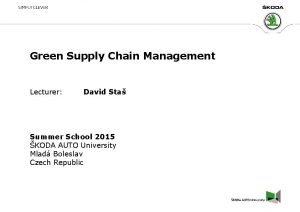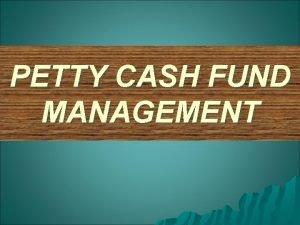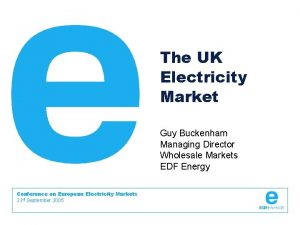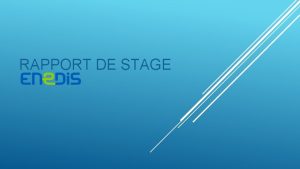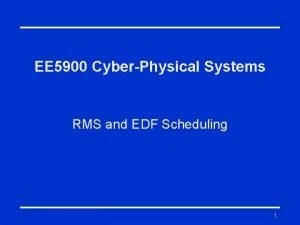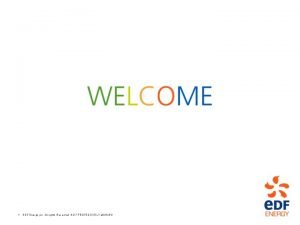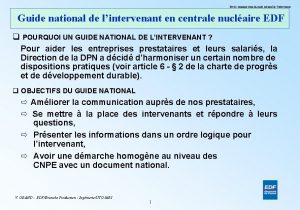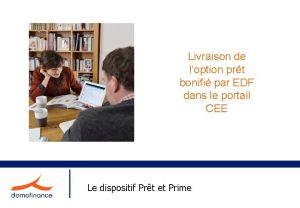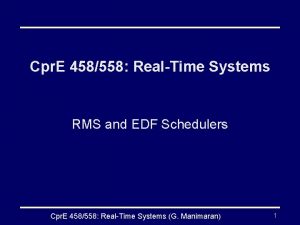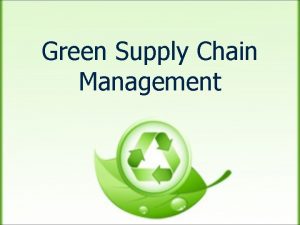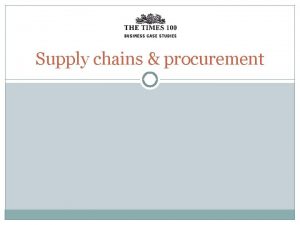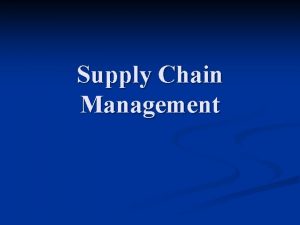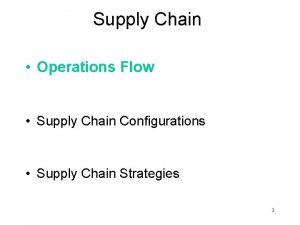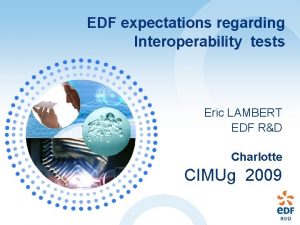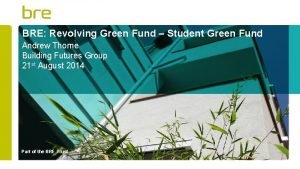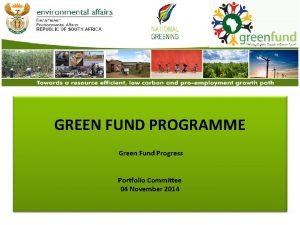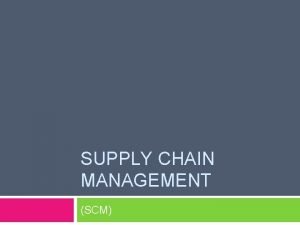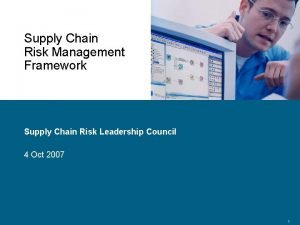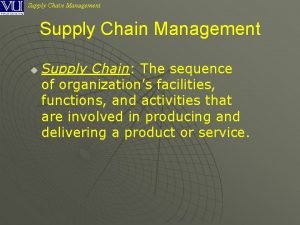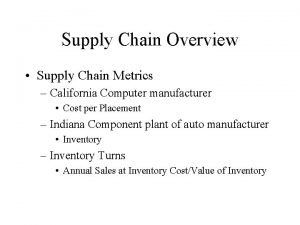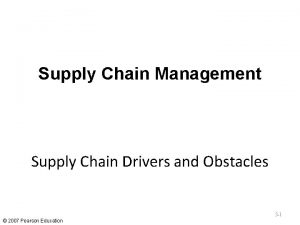Green Supply Chain Environmental Defense Fund EDF Environmental



















- Slides: 19

Green Supply Chain Environmental Defense Fund (EDF)

Environmental Defense Fund (EDF) o Leading Non-profit Organization in the U. S. o Established in 1967; Headquartered in New York o Committed to combining scientific and economic methods to solve the most pressing environmental problems o Succeeded in: • Promoting the DDT Abolition Act • Convincing Mc. Donald’s to ban Styrofoam • Helping to introduce hybrid trucks to Fed. Ex

Environmental Defense Fund (EDF) Annual Budget: $130 Million | Members: 1 Million | Employees: 500 | Offices: 13

Climate Oceans Ecology Health

Environmental Defense Fund - China Program In 1991, the Ministry of Environmental Protection invited EDF to participate in the country’s first experiment using economic incentives in pollution control. Within the next 20 years, EDF implemented its China Program and 6 main projects based on China’s current issues in economic development and environmental protection. 6 Main Projects: Sulfur Dioxide Emission Control & Emissions Trading Environmental Law Enforcement Reducing Greenhouse Gas Emissions from Agriculture Green Supply Chain Public Participation Energy and Power Sector

Green Supply Chain - Definition The concept of Green Supply Chain, initially proposed by Michigan State University in 1996, indicates improving the efficiency of resource use throughout the entire supply chain based upon consideration of environmental effects. Green Design Key Stages: Green Recycling Green Materials Green Marketing Green Manufacturing Green Logistics

Big Data & Supply Chain Management Information sharing in the supply chain helps: Reduce inventory cost Shorten order cycle Accelerate capital returns Strengthen adaptability of supply chain to market conditions o Promote cooperation among suppliers o o o Purchasers to understand, manage and improve suppliers’ environmental performance

Dongguan o Major Industrial and Manufacturing Center in the Pearl River Delta region o Contains many suppliers of international brands (Apple, Dell, Nike, Wal-Mart, IBM etc. ) o Wal-Mart has ~200 suppliers in Dongguan o In 2014, 2/3 of Dongguan’s GDP came from manufacturing and export o Current “Dongguan Mode” : • • • High energy consumption, pollution, labor density and resource use Low efficiency All SMEs Dongguan, Guangdong Province Area: 4265 km 2

Cooperation with Wal-Mart Assess supplier energysaving potential Build government-firm-NGO cooperation Wal-Mart has >200 suppliers in Dongguan Municipal level of Green Supply Chain management

Dongguan Index Domestic Environmental Legislation Government Procurement Requirements International Trade Requirements Consumer Preferences Large Buyer 1. Environment 2. Energy 3. Low-Carbon Supplier Secondary Supplier Tertiary Supplier …

Aligning Index with Dongguan’s Goals o Dongguan’s ozone concentration is the highest in the Pearl River Delta region o Air quality ranking fell from top 10 in May to #44 in September 2015, mainly due to ozone pollution caused by VOCs emissions from manufacturing o The Dongguan government has made combatting ground-level ozone pollution its top environmental priority o Dongguan Index incorporates Dongguan’s effort in ozone control and VOCs emission reduction to aim for a 6% decrease in ozone concentration by the end of 2016 compared to that of 2014, and 80% daily compliance rate; o 6% further decrease in ozone concentration and 85% daily compliance rate by the end of 2017, and through 3 years of combined effort, significantly improve air quality in Dongguan. Through comparing scales, employee populations, export volumes, and environmental impact of different industries, Dongguan Index targets the shoe and furniture manufacturing industries for maximum incentive.

What Makes Dongguan Index Unique? Entire supply chain assessment Holistic performance measurement Assessment of the degree of greening Technical advantage Broad functionality

1. Entire Supply Chain Evaluation Precedent: Dow Jones Sustainability Index (DJSI) o Assesses a company’s sustainability performance based on economic, social and environmental indicators o Specifications only involves primary suppliers o Environmental chapter does not account for the supply chain Dongguan Index assesses performance of both individual large buyers and their upstream suppliers, promoting the greening of the entire supply chain in a step-by-step process.

2. Holistic Performance Measurement Dongguan Index holistically measures a supply chain’s environmental performance based on 3 key aspects: 1. Energy efficiency 2. Environment 3. Low-carbon development Each aspect includes: o Basic – compliance to laws and regulations o Improvement – voluntary actions on improving environmental performance The Dongguan Index incorporates 3 important aspects and weighs different metrics in assessing environmental performance.

Basic Compliance Clean Production … Improvement Environmental Investment Monitoring Automation … Basic Statistics and Measurements Elimination of Outdated Production … Improvement Management System Energy Efficiency Projects … Basic Carbon Trading … Improvement Solar PV Biofuels Use Environmental Dongguan Index Energy Low-Carbon …

3. Assessment of the Degree of Greening Dongguan Index provides not only a score, but also improvement recommendations for all relevant parties, expanding functionality and applicability. Companies can determine which areas to improve based on their score, and effectively allocate resources.

4. Technical Advantage Index Focus Limitations compared to Dongguan Index CITI Index Environmental management in supply chains General and qualitative criteria (Eg. “Encourage Suppliers to Disclose Self-operated Monitoring Data”) Global Reporting Initiative Index (GRI) Supply chain reporting Lack of focus on environmental performance (<6% of total specifications) Climate Disclosure Leaders Index (CDP) Supply chain environmental disclosure Limited topics (only GHG emissions and water and forest resources) The Walmart Sustainability Index by The Sustainability Consortium (TSC) Supply chain sustainability throughout whole product life cycles Mainly based on multiplechoice surveys of suppliers; may be more subjective Red. E Supply chain energy saving Sole focus on energy efficiency

5. Broad Functionality Dongguan Index is useful and applicable for all relevant parties. Users include: 1. Suppliers: identify problems in all 3 aspects of energy, environment, and lowcarbon development and clarify improvement areas through benchmarking. 2. Large buyers: prioritize potential partners with high scores and promote corrective action and green procurement throughout the entire supply chain. 3. Governments: better understand the degree of greening in different industries, and utilize replicable, scalable green supply chain management methods for urban and industrial planning and ecological civilization establishment. 4. Regulation agencies: realize issues in environmental compliance standards, further guide compliance and risk management, and use the index as a prerequisite for government subsidy and tax breaks. 5. Financial institutions: incorporate the index as a component in credit evaluation for financing.

Thank you!
 Red green show
Red green show Matching supply and demand in supply chain
Matching supply and demand in supply chain Example of green supply chain management
Example of green supply chain management What is logistics management
What is logistics management Sequence of food chain
Sequence of food chain Specific defense vs nonspecific defense
Specific defense vs nonspecific defense Usw strike and defense fund
Usw strike and defense fund Imprest fund system adalah
Imprest fund system adalah Guy buckenham edf
Guy buckenham edf Pgi gta edf
Pgi gta edf Cigeo
Cigeo Nigel price md
Nigel price md Rms and edf scheduling example
Rms and edf scheduling example Edf energy
Edf energy Guide national de l'intervenant en centrale nucléaire edf
Guide national de l'intervenant en centrale nucléaire edf Edf
Edf Fiche contact domofinance
Fiche contact domofinance Chs.edf.school
Chs.edf.school Rms edf
Rms edf Rms and edf scheduling example
Rms and edf scheduling example


